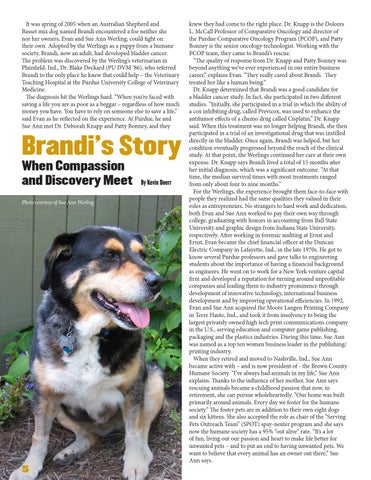It was spring of 2005 when an Australian Shepherd and Basset mix dog named Brandi encountered a foe neither she nor her owners, Evan and Sue Ann Werling, could fight on their own. Adopted by the Werlings as a puppy from a humane society, Brandi, now an adult, had developed bladder cancer. The problem was discovered by the Werling’s veterinarian in Plainfield, Ind., Dr. Blake Deckard (PU DVM ’86), who referred Brandi to the only place he knew that could help – the Veterinary Teaching Hospital at the Purdue University College of Veterinary Medicine. The diagnosis hit the Werlings hard. “When you’re faced with saving a life you are as poor as a beggar – regardless of how much money you have. You have to rely on someone else to save a life,” said Evan as he reflected on the experience. At Purdue, he and Sue Ann met Dr. Deborah Knapp and Patty Bonney, and they
Brandi’s Story When Compassion and Discovery Meet Photo courtesy of Sue Ann Werling.
5
By Kevin Doerr
knew they had come to the right place. Dr. Knapp is the Dolores L. McCall Professor of Comparative Oncology and director of the Purdue Comparative Oncology Program (PCOP), and Patty Bonney is the senior oncology technologist. Working with the PCOP team, they came to Brandi’s rescue. “The quality of response from Dr. Knapp and Patty Bonney was beyond anything we’ve ever experienced in our entire business career,” explains Evan. “They really cared about Brandi. They treated her like a human being.” Dr. Knapp determined that Brandi was a good candidate for a bladder cancer study. In fact, she participated in two different studies. “Initially, she participated in a trial in which the ability of a cox inhibiting drug, called Previcox, was used to enhance the antitumor effects of a chemo drug called Cisplatin,” Dr. Knapp said. When this treatment was no longer helping Brandi, she then participated in a trial of an investigational drug that was instilled directly in the bladder. Once again, Brandi was helped, but her condition eventually progressed beyond the reach of the clinical study. At that point, the Werlings continued her care at their own expense. Dr. Knapp says Brandi lived a total of 15 months after her initial diagnosis, which was a significant outcome. “At that time, the median survival times with most treatments ranged from only about four to nine months.” For the Werlings, the experience brought them face-to-face with people they realized had the same qualities they valued in their roles as entrepreneurs. No strangers to hard work and dedication, both Evan and Sue Ann worked to pay their own way through college, graduating with honors in accounting from Ball State University and graphic design from Indiana State University, respectively. After working in forensic auditing at Ernst and Ernst, Evan became the chief financial officer at the Duncan Electric Company in Lafayette, Ind., in the late 1970s. He got to know several Purdue professors and gave talks to engineering students about the importance of having a financial background as engineers. He went on to work for a New York venture capital firm and developed a reputation for turning around unprofitable companies and leading them to industry prominence through development of innovative technology, international business development and by improving operational efficiencies. In 1992, Evan and Sue Ann acquired the Moore Langen Printing Company in Terre Haute, Ind., and took it from insolvency to being the largest privately owned high tech print communications company in the U.S., serving education and computer game publishing, packaging and the plastics industries. During this time, Sue Ann was named as a top ten women business leader in the publishing/ printing industry. When they retired and moved to Nashville, Ind., Sue Ann became active with – and is now president of - the Brown County Humane Society. “I’ve always had animals in my life,” Sue Ann explains. Thanks to the influence of her mother, Sue Ann says rescuing animals became a childhood passion that now, in retirement, she can pursue wholeheartedly. “Our home was built primarily around animals. Every day we foster for the humane society.” The foster pets are in addition to their own eight dogs and six kittens. She also accepted the role as chair of the “Serving Pets Outreach Team” (SPOT) spay-neuter program and she says now the humane society has a 95% “out alive” rate. “It’s a lot of fun, living out our passion and heart to make life better for unwanted pets – and to put an end to having unwanted pets. We want to believe that every animal has an owner out there,” Sue Ann says.
